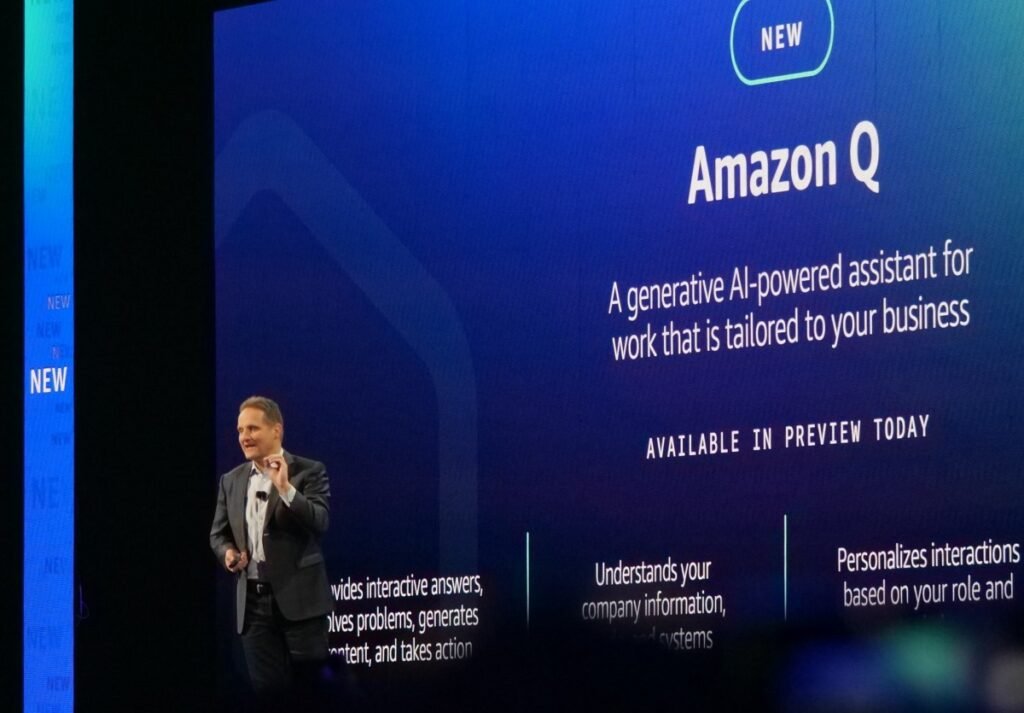At the AWS re:Invent event, AWS CEO Adam Selipsky unveiled a new AI-powered chat tool named Amazon Q AI Chatbot. This tool, designed for businesses, allows users to ask company-specific questions using their own data. For instance, employees can use Amazon Q to inquire about the most recent logo usage guidelines or to comprehend a colleague’s code for app maintenance. Instead of manually searching through numerous documents, Amazon Q AI Chatbot can provide the required information.
This announcement, made at the Reinvent conference of Amazon Web Services (AWS) in Las Vegas, signifies Amazon’s ongoing efforts to compete with Microsoft and Google in the realm of productivity software. This comes a year after the launch of the ChatGPT chatbot by OpenAI, a startup backed by Microsoft, which has brought generative artificial intelligence to the forefront for generating text that mimics human conversation based on a few lines of human input.
Amazon Q AI Chatbot can be accessed via the AWS Management Console, the documentation pages of individual companies, developer environments such as Slack, and other third-party applications. Selipsky emphasized that the queries posed to Amazon Q AI Chatbot will not be utilized to train any foundational models.
The chatbot Q is named after a character from either the James Bond films or the Star Trek TV series, depending on which AWS executive you speak to.
A preview version of Q is currently available, with several features accessible at no cost. Once the preview phase concludes, a business user tier will be priced at $20 per person monthly. A version with extra features for developers and IT professionals will be priced at $25 per person monthly. In comparison, both the Copilot for Microsoft 365 and Duet AI for Google Workspace for business users are priced at $30 per person monthly.
Initially, Amazon Q AI Chatbot will assist users in understanding AWS capabilities and troubleshooting issues. Users can interact with it via communication apps like Salesforce’s Slack and text-editing applications for software developers, as stated by AWS CEO Adam Selipsky at the Reinvent stage. Q will also be integrated into AWS’ online Management Console and can provide document citations to support its chat responses.
According to Selipsky, the Amazon Q AI Chatbot can autonomously modify source code, reducing the workload for developers. The service will be compatible with over 40 enterprise systems. Consequently, with Q, users can discuss information stored in Microsoft 365, Dropbox, Salesforce, and Zendesk, as well as AWS’ S3 data storage service. Users will also have the ability to upload and inquire about documents while interacting with Q.
Amazon Q AI Chatbot can interact with all models housed in Amazon Bedrock, AWS’s AI model repository, including Meta’s Llama 2 and Anthropic’s Claude 2, was introduced. Customers frequently select the model that best suits their needs, connect to the Bedrock API for that model, use it to understand their data, policies, and workflow, and then deploy Amazon Q.
Amazon Q AI Chatbot, which has been trained on 17 years of AWS knowledge, can be used to ask AWS-specific questions and recommend the most suitable AWS services for a project.
At present, Amazon Q AI Chatbot is exclusively available to Amazon Connect users, an AWS service for contact centers. It will eventually be extended to other services such as Amazon Supply Chain, which aids customers in monitoring their supply chain management, and Amazon QuickSight, AWS’s business intelligence platform. A preview of Amazon Q for business intelligence is currently available.
Steven Dickens, vice president and practice leader at the Futurum Group, a technology industry research firm, wrote, “AWS Q will revolutionize the experience for AWS customers who have a multitude of, often overlapping, service options to navigate. AWS has refrained from creating an AI assistant for each service in its portfolio, and as a result, I anticipate Q will be widely adopted in the coming months by both developers and cloud administrators.”
Over the years, Amazon has launched several applications for end-users, including tools for managing supply chains, email, encrypted messaging, video calls, customer service, and marketing outreach. However, none of these have achieved significant success, and the majority of AWS’ revenue is derived from fundamental computing and storage services.
Deepak Singh, an AWS vice president, stated that administrators will have the ability to decide whether Amazon Q AI Chatbot can respond to users’ general topic inquiries. Deepak Kumar expressed, “Our aim was to initially integrate the technology with the services where it would be most beneficial. In the case of contact centers, supply chain, and business intelligence, the application of AI is inherently appropriate.”

